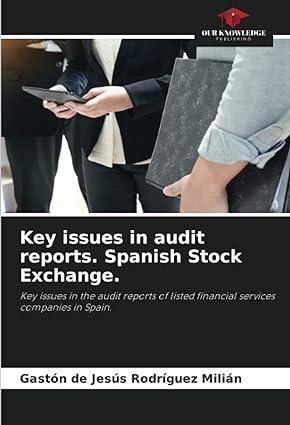Answered step by step
Verified Expert Solution
Question
1 Approved Answer
meaningful? Is its book debt-equity ratio meaningful? Explain. c. Find the company's other financial statements from that time online. What was the cause of the
meaningful? Is its book debt-equity ratio meaningful? Explain.
c. Find the company's other financial statements from that time online. What was the cause of the change to its book value of equity at the end of 2015?
d. Does the company's book value of equity in 2016 imply that it is unprofitable? Explain.
a. What change in the book value of the company's equity took place at the end of 2015?
The book value of equity
increased
by $ 1212 billion from the end of the previous year, and was
positive
. (Select from the drop-down menus and round to three decimal places.)
b. Is the company's market-to-book ratio meaningful? Is its book debt-equity ratio meaningful? Explain.(Select all the choices that apply.)
A.
Because the book value of equity is positive in this case, the company's market-to-book ratio and its book debt-equity ratio are not meaningful.
B.
Because the book value of equity is negative in this case, the company's market debt-equity ratio may be used in comparison.
C.
Because the book value of equity is negative in this case, the company's market-to-book ratio and its book debt-equity ratio are not meaningful.
D.
Because the book value of equity is positive in this case, the company's market debt-equity ratio may be used in comparison.
c. Find the company's other financial statements from that time online. What was the cause of the change to its book value of equity at the end of 2015? (Select all the choices that apply.)
A.
Information from the statement of cash flows helped explain that the increase of book value of equity resulted from an increase in debt that was used to repurchase $2.112 billion worth of the firm's shares.
B.
Information from the statement of cash flows helped explain that the decrease of book value of equity resulted from an increase in debt that was used to repurchase $2.112 billion worth of the firm's shares.
C.
Information from the statement of cash flows helped explain that the increase of book value of equity resulted from an decrease in debt that was used to repurchase $2.112 billion worth of the firm's shares.
D.
Information from the statement of cash flows helped explain that the decrease of book value of equity resulted from an decrease in debt that was used to repurchase $2.112 billion worth of the firm's shares.
d. Does the company's book value of equity in 2016 imply that it is unprofitable? Explain.(Select all the choices that apply.)
A.
If a firm borrows to repurchase shares or invest in intangible assets (such as R&D), it can have a negative book value of equity.
B.
Negative book value of equity does not necessarily mean the firm is unprofitable.
C.
Negative book value of equity means the firm will most likely file for bankruptcy.
D.
Negative book value of equity means the firm is unprofitable.
Click to select your answer(s).
Step by Step Solution
There are 3 Steps involved in it
Step: 1

Get Instant Access to Expert-Tailored Solutions
See step-by-step solutions with expert insights and AI powered tools for academic success
Step: 2

Step: 3

Ace Your Homework with AI
Get the answers you need in no time with our AI-driven, step-by-step assistance
Get Started


